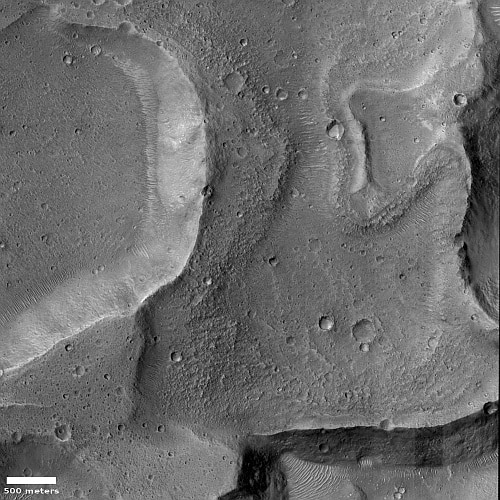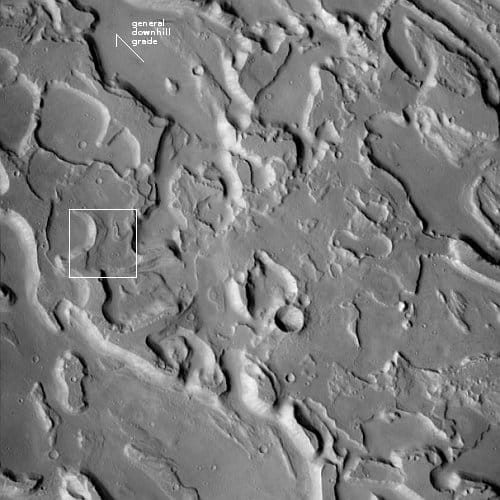Jumbled floor of ancient Martian channel
Cool image time! The picture to the right, rotated, cropped, reduced, and sharpened to post here, was taken on February 2, 2023 by the high resolution camera on Mars Reconnaissance Orbiter (MRO).
At first glance I thought I was looking at a variety of eroding glacial flows. I was completely wrong. This terrain is located on the floor of 900-mile-long Ares Vallis, thought to have been carved eons ago by some flow, either liquid catastrophic floods or glacial ice, but is now located in the very dry equatorial regions of Mars.
Then what caused these meandering ridges? The overview map below, plus the wider view of MRO’s context camera, provides us more data but little illumination. In fact, both leave us more questions and mysteries.

The white dot on the overview map to the right, in Ares Vallis south of where Pathfinder landed and where Franklin will land hopefully in 2028, marks this location. As I noted, this is in the dry equatorial regions. If there was surface or near-surface ice or water here once, it is no longer evident. These ridges are bedrock of some kind, though some form of erosion has shaped them.
The second image to the right, rotated, cropped, reduced, and sharpened to post here, was taken on November 8, 2012 by MRO’s context camera. The white box marks the area covered by the high resolution image above.
Note how almost all the terrain appears to have no relation to the general downward grade of Ares Vallis. There are hints of a southeast-to-northwest trend, but only in some areas and only vaguely.
Yet, this terrain is in the floor of this channel, and was carved by whatever once flowed through it, traveling from the southeast to the northwest. The random shapes we see now must be from some subsequent erosion process, possibly associated with any near surface ice that might have once existed here but certainly related to later wind erosion. According to the science team for Mars Express, referring to similar terrain much farther upstream in Ares Vallis:
A chaotic distribution of individual blocks of rock and hills forms a disrupted pattern. These ‘knobs’ are several hundred metres high. Scientists suggest that they are remnants of a pre-existing landscape that collapsed after cavities had formed beneath the surface.
The blocks and hills in that upstream region however show more evidence of the downstream flow. It could be that by the time that flow reached the region in today’s pictures the force of the flow had dissipated somewhat so that the terrain no longer shows as much evidence of it.
On Christmas Eve 1968 three Americans became the first humans to visit another world. What they did to celebrate was unexpected and profound, and will be remembered throughout all human history. Genesis: the Story of Apollo 8, Robert Zimmerman's classic history of humanity's first journey to another world, tells that story, and it is now available as both an ebook and an audiobook, both with a foreword by Valerie Anders and a new introduction by Robert Zimmerman.
The print edition can be purchased at Amazon or from any other book seller. If you want an autographed copy the price is $60 for the hardback and $45 for the paperback, plus $8 shipping for each. Go here for purchasing details. The ebook is available everywhere for $5.99 (before discount) at amazon, or direct from my ebook publisher, ebookit. If you buy it from ebookit you don't support the big tech companies and the author gets a bigger cut much sooner.
The audiobook is also available at all these vendors, and is also free with a 30-day trial membership to Audible.
"Not simply about one mission, [Genesis] is also the history of America's quest for the moon... Zimmerman has done a masterful job of tying disparate events together into a solid account of one of America's greatest human triumphs."--San Antonio Express-News
Cool image time! The picture to the right, rotated, cropped, reduced, and sharpened to post here, was taken on February 2, 2023 by the high resolution camera on Mars Reconnaissance Orbiter (MRO).
At first glance I thought I was looking at a variety of eroding glacial flows. I was completely wrong. This terrain is located on the floor of 900-mile-long Ares Vallis, thought to have been carved eons ago by some flow, either liquid catastrophic floods or glacial ice, but is now located in the very dry equatorial regions of Mars.
Then what caused these meandering ridges? The overview map below, plus the wider view of MRO’s context camera, provides us more data but little illumination. In fact, both leave us more questions and mysteries.

The white dot on the overview map to the right, in Ares Vallis south of where Pathfinder landed and where Franklin will land hopefully in 2028, marks this location. As I noted, this is in the dry equatorial regions. If there was surface or near-surface ice or water here once, it is no longer evident. These ridges are bedrock of some kind, though some form of erosion has shaped them.
The second image to the right, rotated, cropped, reduced, and sharpened to post here, was taken on November 8, 2012 by MRO’s context camera. The white box marks the area covered by the high resolution image above.
Note how almost all the terrain appears to have no relation to the general downward grade of Ares Vallis. There are hints of a southeast-to-northwest trend, but only in some areas and only vaguely.
Yet, this terrain is in the floor of this channel, and was carved by whatever once flowed through it, traveling from the southeast to the northwest. The random shapes we see now must be from some subsequent erosion process, possibly associated with any near surface ice that might have once existed here but certainly related to later wind erosion. According to the science team for Mars Express, referring to similar terrain much farther upstream in Ares Vallis:
A chaotic distribution of individual blocks of rock and hills forms a disrupted pattern. These ‘knobs’ are several hundred metres high. Scientists suggest that they are remnants of a pre-existing landscape that collapsed after cavities had formed beneath the surface.
The blocks and hills in that upstream region however show more evidence of the downstream flow. It could be that by the time that flow reached the region in today’s pictures the force of the flow had dissipated somewhat so that the terrain no longer shows as much evidence of it.
On Christmas Eve 1968 three Americans became the first humans to visit another world. What they did to celebrate was unexpected and profound, and will be remembered throughout all human history. Genesis: the Story of Apollo 8, Robert Zimmerman's classic history of humanity's first journey to another world, tells that story, and it is now available as both an ebook and an audiobook, both with a foreword by Valerie Anders and a new introduction by Robert Zimmerman.
The print edition can be purchased at Amazon or from any other book seller. If you want an autographed copy the price is $60 for the hardback and $45 for the paperback, plus $8 shipping for each. Go here for purchasing details. The ebook is available everywhere for $5.99 (before discount) at amazon, or direct from my ebook publisher, ebookit. If you buy it from ebookit you don't support the big tech companies and the author gets a bigger cut much sooner.
The audiobook is also available at all these vendors, and is also free with a 30-day trial membership to Audible.
"Not simply about one mission, [Genesis] is also the history of America's quest for the moon... Zimmerman has done a masterful job of tying disparate events together into a solid account of one of America's greatest human triumphs."--San Antonio Express-News



